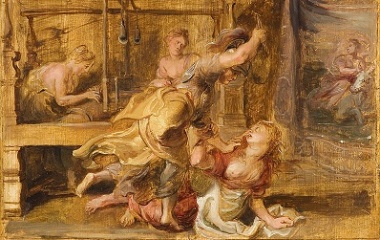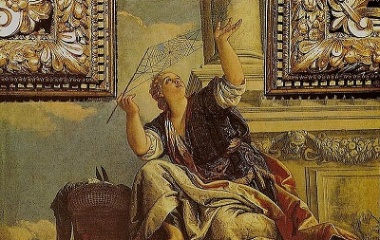- Pronunciation: Ah-rack-knee
- Origin: Greco-Roman
- Type: Mortal human
- Powers: Legendary weaver
- Known for: Becoming the world’s first spider
Although the gods of ancient Greece were all phenomenal and superhuman in many ways, sometimes the mortals of the world could rise to rival their skill and powers. The gods of the Greek pantheon were not exactly known for being immune to jealousy or pride, so being shown up by a mortal human rarely ended well for the mortal in question.
This is a lesson that one mortal from Greco-Roman mythology learnt the hard way. Her name was Arachne and her duel with Athena, the goddess of wisdom and craftsmanship, is a tale retold over the centuries. It’s a story with many different endings, but always ending with poor Arachne transformed into a spider.
Who Is Arachne?
For all intents and purposes, Arachne was an unremarkable mortal human woman, but for one detail: she was an incredible weaver. A simple shepherd’s daughter in some stories, or the daughter of a dyer in others, she began to weave from a very early age and showed greater talent than any other mortal for this craft.
We know very little about her personal life, other than the fact that it revolved around the craft of weaving. This is not only a contrivance for the sake of her story, as we see in the tales about Arachne that weaving really was the only thing she seemed to care about.
Appearance
Since she is just a mortal human like any other, Arachne is often simply depicted as an average woman sitting at a loom or spinning wheel.
She is often shown at her craft, but also opposite Athena demonstrating body language that clearly shows defiance and pride.
There have also been many depictions of Arachne’s transformation into a spider, which is very appealing to artists on several levels. We don’t know much about the details of her transformation, so these artist impressions vary a lot. Some show her as a sort of spider-centaur, with a human upper body. Others show her as a giant spider.
Family
Depending on the source, Arachne is the daughter of either an unnamed shepherd or, more usually, the daughter of a Lydian man by the name of Idmon of Colophon. Idmon was famous in his own right as a dyer in purple. We have to remember that in ancient times, purple dye was extremely rare and expensive, which is why it was often reserved for royalty. In the version of the story where Idmon is Arachne’s father, she is not quite such an everyman, but starts off as a woman of some pedigree.
By some accounts, she also had a son named Kloster, but there are few details about him. Of course, all spiders in the world today are her offspring as well.
Origin and History
Most of what we know about Arachne’s story comes from Ovid’s Metamorphosis, which is a Roman-era poem. It’s in this story that she is the daughter of a shepherd rather than of Idmon.
Arachne boasted that her famous weaving skills were greater than even Athena’s. The goddess appeared to her in disguise, warning her that her pride (or hubris, as the Greeks called it) was dangerous to her. Athena advised her to ask for forgiveness, but Arachne was unrepentant.
Athena then appeared to her properly after Arachne issued a challenge to her. Athena wove a depiction of the gods punishing mortals who got too uppity, while Arachne wove a depiction showing how the gods were jerks a lot of the time to mortals.
Athena saw that not only was Arachne’s tapestry an insulting jab at the gods, it was also a much nicer work than hers. The goddess of wisdom flew into a rage, ripping up Arachne’s work and turning her into a spider with a poison from the goddess Hecate. Arachne and her descendants were cursed to weave forever.
Other retellings of the story have Athena as the winner of the contest and the stakes being that the loser can never touch a weaving loom or spinning wheel again. Athena, however, takes pity on Arachne after she sees how much weaving means to her, so she “kindly” turns her into a spider so that she can keep weaving without needing those tools.
Sometimes Arachne wins, but then commits suicide as a result of the guilt she feels at her insolence. That is, guilt she felt after Athena blessed her with the wisdom to see her mistake. Athena then resurrects her as a spider.
While these different stories have major details that are not the same, they all share a few common elements, most notably that Arachne ends up as a spider. More importantly, she is the first spider ever, and all spiders today are her children. Arachne may also be seen as the goddess of spiders in some versions of her tale.
Modern Influence
The family of creatures that include spiders and scorpions are known as arachnids, so named because of the Arachne story.
Ovid’s poem has also been the inspiration for a number of other works, which include more poems, novels and paintings.
In modern times, characters inspired by some aspect of Arachne’s story or character appear in films, comic books or video games. For example, in the game Final Fantasy IV, there is a monster named Arachne that the player must fight.
The popular Japanese manga and anime “Monster Musume” has a character whose looks are loosely-based on Arachne’s, with a human upper body.
Famously, the second Spider Woman in Marvel’s comic universe also used the name Arachne.
Even today, her story serves as a classic demonstration of the dangers of hubris and how mankind, despite its mastery of the crafts, must know its place in the natural order.










